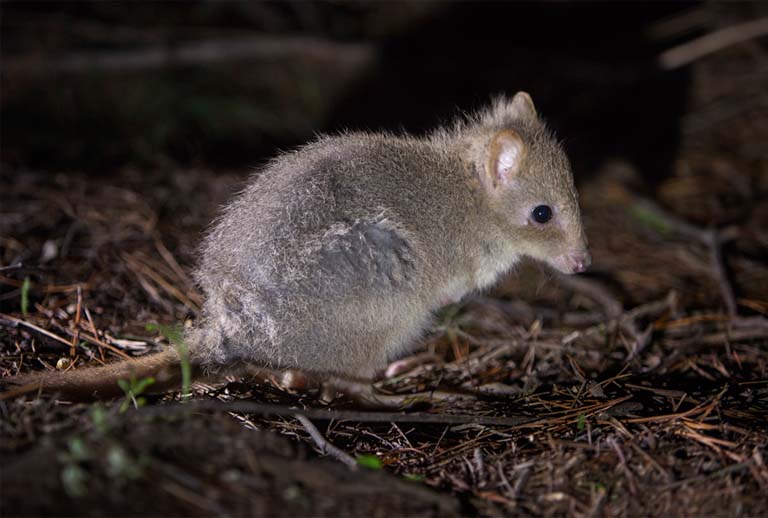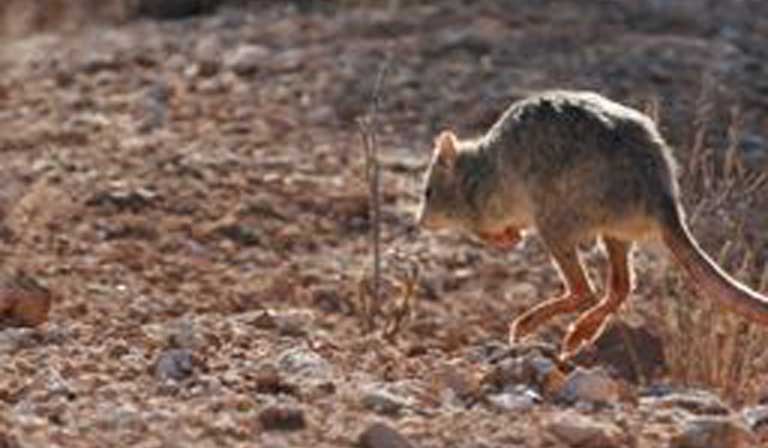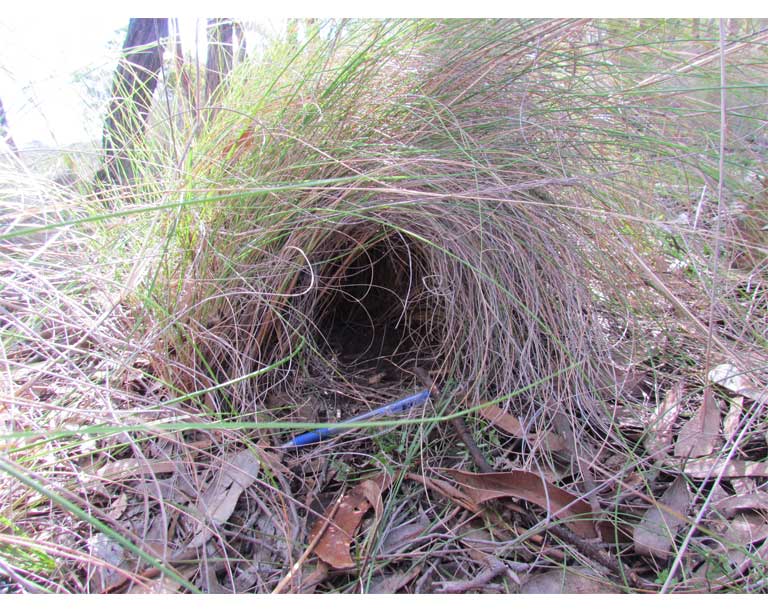- Australia’s tiny jumpers, known as bettongs, are in trouble; once exterminated as agricultural pests they are threatened by habitat loss and introduced predators such as foxes and cats.
- Scientists recently learned that bettongs act as one of nature’s engineers, dramatically encouraging and enhancing Australia’s forest habitat in numerous ways.
- Bettong restoration efforts are well supported by the national and state governments, with fenced-in populations thriving — though much remains to be done to encourage the return of the bettong to the broader Australian landscape.
Most people know and love marsupials like kangaroos and koalas, but some members of this infraclass are virtual unknowns — despite facing similar extinction threats — and being just as cute. One example is an underappreciated group of small wallabies called bettongs, rabbit-sized bouncers once widespread across Australia but now reduced to just a few small colonies and captive populations.
The tale of the bettong isn’t an uncommon one in Australia. The giant island country has the world’s worst mammal extinction rate. One in three of the mammals that have gone extinct worldwide in the past 400 years were Australian species. Today 30 percent of the country’s endemic mammals are threatened with extinction.

Rob Brewster, the Director of Rewilding Australia, a nonprofit working to restore the country’s endangered native species and habitats, explains that in the last few hundred years things have gone downhill for almost all endemic critical weight species — those between 35 grams and 5.5 kilograms (roughly ranging from 1 ounce to 12 pounds). The bettong is no exception, sitting at an average 1.2 to 1.9 kilograms (2.7 to 4.2 pounds).
“Bettongs are like a furry Mars bar to foxes and feral cats,” says Brewster. “Causing their massive decline some 150 years ago. It didn’t help that settlers tended to shoot anything that hopped or dug — bettongs do both.”
Bettongs on the ropes, and bettong hopes
Europeans brought foreign predators and cleared land for agriculture, permanently altering the Australian landscape. Though the Aboriginals knew the night-jumpers as bettongs, translating to small wallaby, colonizers picked a far less flattering and catchy name, dubbing them “rat-kangaroos”. Throughout the 19th century bettongs were bounty hunted as agricultural pests, forced to compete against acclimatizing invasive rabbits for resources, and nearly eaten to extinction by foxes.

Somehow the resilient hoppers persevered, but at a cost. By the 1940s at least four sub-species of bettongs were extinct, and each surviving species — the Brush-tailed,
Tasmanian, Northern and Burrowing — were in trouble. The Tasmanian and Burrowing bettong were also lost from the mainland and restricted to islands, and the Northern and Brush-tailed confined to extreme tips of their former range.
In the 1970s and 80s populations dwindled even more dramatically as a new threat loomed: changed fire regimes. Bettongs prefer wildfire-prone woodlands and grasslands, so when natural burn cycles were suppressed, their habitats quickly transformed into rainforests. These sharp losses gained government attention, and two of the species regional and national endangered status — the Brush-tailed in 1982 and the Northern in 1994. Currently all species are classified as either Vulnerable or Endangered on state and national levels.

Reintroduction projects maintain populations of each species, but successes have been varied and progress slow. Fox-control methods coupled with captive breeding programs caused such a resurgence in Brush-tailed bettongs that in 1996 they were delisted from both State and Commonwealth threatened species lists.
But once on their own, the little guys floundered. Since 2001, between 25 and 90 percent of Brush-tailed populations are being lost annually — matching a similar trend amongst all bettong species. Today, the Brush-tailed bettong is considered Critically Endangered by the IUCN, while Northern bounders are listed as Endangered, and the Tasmanian and Burrowing are Near Threatened.
Though the reasons for these declines, and the uneven results of bettong reintroduction programs, aren’t fully understood, some blame cat-carried parasites like toxoplasmosis, spread to bettongs through buried feces. But pesky invasive species are likely still the root problem. Some researchers maintain that nonnative cats are eating their way through holdout populations in Tasmania (while others blame foxes, though none have been sighted there). Feral pigs are encroaching on the four known Northern bettong communities. And of course, the continuing loss of habitat remains a problem.

“The fate of a reintroduced species is never certain,” says Adrian Manning, an ecologist with the Australian National University’s Fenner School of Environment and Society. “At least not until the rest of the landscape has also been restored.”
Ongoing efforts aim to prevent Australia’s endemic mammals from becoming a thing of the past. Programs like Western Shield, a 1080 fox-baiting program established in 1996, or the fox-free taskforce in Tasmania, running from 2006 to 2014 and now operating as an invasive species hotline, have proven effective.
Still, big roadblocks remain. In the bettong’s case, probably the largest one being that they very rarely get the spotlight. The Northern bettong currently doesn’t even have a total population estimate.
When Randy Rose, a now retired zoologist from the University of Tasmania, did his PhD. on Tasmanian bettongs in 1984, he was the first to publish on the species since T.T. Flynn (father of movie star Errol), back in 1931. “Australia has a small population, so there are less marsupial specialists than marsupial species,” Rose explains.
But there might be another way to secure the fate of Australia’s bettongs, based on the little marsupial’s picky palate.
Nature’s ecological engineers
Much about bettongs remains mysterious, but one clear fact is that they are important forest stewards. By human standards, these rare mammals have exceedingly rich tastes, relying on truffles — fruiting fungi bodies — for more than 50 percent of their nutritional needs. This preference isn’t random — it comes with serious ecological advantages for both the tiny marsupials and the forest ecosystems they mine.

Truffles are like underground cacti, holding precious water reserves and exchanging hard to acquire nutrients with the roots of eucalyptus, acacia and other tree species with which they associate. These truffle reservoirs help preserve forests in times of drought or prolonged heat waves, of which there are many in Australia — with increasingly more projected due to escalating climate change. Bettongs play a primary role in upholding and enhancing this forest ecosystem regime.
Karl Vernes, an associate professor with Australia’s University of New England, calls bettongs ecological engineers, digging more than 100 teacup-shaped holes in their nightly pursuit of truffles that catch rainwater otherwise lost as runoff. Their choice of nest-location, and rotational scavenging habits, are also ecologically beneficial. Building their nests under trees, the night-bounders gather grasses with their prehensile, grasping tails, to construct a temporary wallow every few days while foraging their range. The Burrowing bettong is the exception; it builds vast underground tunnel networks.
Bettongs defecate large amounts of undigested truffle spores while living in these makeshift underground homes or digging up fungal delicacies — which given their up to 120-hectare (206 acre) range — leads to a wide dispersion of the truffles. Vernes reports that bettongs have been documented to consume at least 60 different fungal species critical to the health of the trees they bond with, probably many more.

“Without the truffle-forming fungi growing on their roots, the trees can’t be healthy —but the fungi rely on truffle specialists to thrive,” says Vernes. “Bettongs are the most important of these; they eat more types of fungi than any other mammal in the forests they inhabit.”
Bettongs are also important to the renewal process after disruptive events such as fires, spreading seedlings and their associated fungal spores in the desolated habitats. Researchers have discovered that bettongs help reduce the chance of brushfires too, by burying leaf litter that otherwise dries to become food for fires.
Manning, who is using the bettong’s exclusive environmental skillset to study habitat restoration, says it’s entirely likely these little creatures have even more of an impact on the landscape than is known today. “Bettongs have such a profound effect on the ecosystem; we’re still at the stage of trying to fully quantify it,” he says.
Bettongs as conservation tools
Manning is part of a major undertaking at Mulligans Flat Woodlands Sanctuary, studying Australia’s habitats by reconstructing them from the ground up, introducing individual species one at a time to study their role in reforming the biome. The project is focused on restoring box-gum grassy woodlands, habitats reliant on the diggings of species like the bettong.

The research was greatly facilitated by the construction of an 11.5-kilometer government-funded fence around the sanctuary in 2009, to keep out invasive cats and foxes — an endeavor that cost $1.3 million AUSD. The fence has a floppy top that overhangs to keep clever cats out, plus two electrified wires, and is monitored by wireless telemetry for breaks or damage.
When it came time to repopulate this isolated experimental plot with mammals, Manning says the bettong was a natural choice — in particular the Eastern bettong, a subspecies of the Tasmanian bettong that had historically roamed the southeastern mainland.
“When looking at which species would be best to bring back first, to begin the renewal cycle in these habitats, it turned out Eastern [Tasmanian] bettongs were the major player,” says Manning. “This led us to bring them back to the mainland, choosing genetically diverse individuals from surviving populations in Tasmania.” Manning notes they were lucky these bettongs with founder-potential still exist. Limited gene flow in fragmented and fractioned populations leads to infertility, and less fit individuals on the whole, quickening the pace of extinction.

But translocating bettongs was no easy feat. Manning explains that bettongs are fast, feisty critters, and pretty high strung. On top of that, they’ve got fairly delicate appendages, like most pro-jumpers. The researchers had to figure out how to safely sedate the animals, and contain them while traveling — deciding to hang nets within boxes to keep the animals from hopping about and injuring themselves.
Their efforts proved highly rewarding. In 2011, breeding individuals were brought to the mainland, and the following year, more were transferred directly into the fence-bound Sanctuary.
“Within 24 hours the bettongs released in the Flat were dutifully digging up truffles,” says Manning. “Clearly all these little guys need is basic protection — they’re eager to do the rest.”

Today this population is bustling — having grown from 60 to 250 individuals in the past four years. Bettongs can breed up to 3 times a year, and each animal lives between three and five years in the wild. Young gestate for 21 days before entering the world, then spend the next 15 weeks in their mom’s protective pouch. Such a fast generation time means it doesn’t take long for protected bettong colonies to flourish — with extraordinary and prestigious engineering results: right now in their experimental home, each individual is moving close to 8 kilograms (17.6 pounds) of soil per night.
But it’s important to note that the Flat is not for the exclusive benefit of bettongs.
The research team’s motivation — beyond the rare chance to answer applied ecology questions on ideal testing grounds — is to provide the Australian government with more solid science on ecological restoration and preservation methods. Manning says the whole project, the reintroduction and research landscape together, has cost about $2.6 million AUSD, funded by an Australian Research Council Linkage grant and partners involved in the research. “All-in-all the reintroduction was very good value for money — and I’d argue, shows the value of integrating restoration with research — that latter maximizing the effectiveness and success of the former,” he says.

The project has led to big initial wins for bettongs, proving their value to forest health. The promising results make a strong case for the inclusion of bettongs in similar future environmental restoration projects.
Right now efforts are underway to make more room for the Sanctuary’s reintroduced bettongs by extending the predator-proof fence, a need explained by the campaign’s quirky mascot, Brian the Bettong. Manning says the researchers are also looking at beyond-the-fence possibilities for Australia’s once abounding small wallies. These restoration costs will be dictated by the size of the enclosure individual communities choose to offer their new bettongs, Manning says.
Predator-proof methods have been pretty successful thus far. The Scotia Wildlife Sanctuary, a 64,659-hectare (159,776 acre) reserve in the Southeast of the country established in 1994 by the non-profit Australian Wildlife Conservancy, has 8,000 hectares (20,000 acres) behind fences. While the numbers of Brush-tailed bettongs in other parts of Australia continue to flop, Scotia’s communities are thriving, having grown from 57 members to 400 in the last 15 years. They’ve also got a relatively massive Burrowing bettong population of around 2,000 individuals. And this is just one example of the estimated 37 similar protective fences at play in Australia, enclosing some 35 thousand hectares of land. And plenty of State governments, like that of New South Wales, have committed to installing predator-proof fences in National Parks.

In June of this year, the federal government announced it would explore non-enclosed survival projects as a mid-range goal in a commitment to bring back ten mammals that are extinct in the wild — including both the Burrowing and Brush-tailed bettong. There’s also an ambitious feral cat-eradication program underway, aiming to kill around 2 million cats in the first five years.
Brewster says beyond-the-fence pursuits should be a priority, especially the return of native top-predators, like the Tasmanian devil, to the mainland — a predator known to frighten off cats and foxes alike, that can effectively compete with them for resources, and that occasionally eats them. Dingoes have similar characteristics.
“Fences can’t be our future,” says Brewster, “maybe for the next 100 years, but not the next 1,000.”
Feeling the bettong-love
Though they still go by affectionate nicknames like the “woylie” (Brush-tailed) and “boodie” (Burrowing), in most places bettong sightings are a thing of the past. The fact that the truffle-hunters are nocturnal doesn’t make them easy to spot either. According to Vernes many Australians don’t even know what a bettong is, let alone about their plight.
But bettongs’ role in enhancing endangered ecosystems, recently discovered by science, combined with their adorable flattened snouts and T-Rex like underdeveloped front limbs, may just be enough to ensure their survival. But that’s yet to be determined. The government, with the help of charities, universities, trusts and non-profits, does seem willing to foot the bill to save what’s left of Australia’s shattered biodiversity. And big nature groups like WWF Australia have drawn up intensive recovery-blueprints for all four bettong varieties, and 17 other species, as part of their 2011-2021 Action Plan for Threatened Australian Macropods. Outlining the predictive tools, research, and manpower necessary to meet important bettong conservation goals in the next 10 years, the plan states it will take around $65 million AUSD to make these plans a reality.

But the public needs to be invested too, advises Vernes. “I think if the average person knew more about our unique mammals like bettongs, they might be more committed to saving them,” he says. Big enclosures are important to boost bettong numbers, but small, spread out stake-holds in private farms and backyard acreage are what will allow the animals to re-conquer their formerly vast range.
It will take a lot of work to undo the generations of human carelessness that has put Australia’s wildlife at risk, but it’s not too late to embrace overlooked species like the bettong. They may be small and have an outmoded defense strategy, freezing in the face of predators, but they do have promise of a rebound. With a little love, a lot more recognition, and a little help, bettongs could regain their historical legacy — bouncing across Australia’s diverse environments in abundance.

Review questions for educators
These questions can help provide a framework for exploring topics presented in this story.
- Is a bettong a rodent?
- Why does Australia have the world’s worst mammal extinction rate?
- Why are bettongs threatened?
- How are conservationists working to protect bettongs?
- Why are bettongs important to the ecosystems they inhabit?













